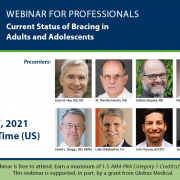Isico among the attendees of the November SRS webinar
A new webinar for professionals is scheduled for November 7, part of the cycle of those organized in recent months by the SRS (available on the pages of the society’s website).
Two specialists from Isico, our scientific director, Prof. Stefano Negrini and Dr. Fabio Zaina, Isico physiatrist will be taking part in this online event titled Current Status of Bracing in Adults and Adolescents:An SRS-SOSORT Collaboration.
Join the SRS Non-Operative Committee and the Society on Scoliosis Orthopaedic and Rehabilitation Treatment (SOSORT) for a webinar analyzing the current evidence and practice guidelines for bracing for adolescent and adult patients with spinal deformity.
This webinar will provide a systematic analysis of the current evidence and best practice guidelines for bracing management of patients with spinal deformity in both adolescents and adults. With variations in brace design and documentation of long-term benefits, use the consensus discussed to clarify your current practice and brace selections.
There will be an update on the current training of Orthotists, including specialization, fabrication, fitting and deformity correction.
To register please visit the page of the SRS website


